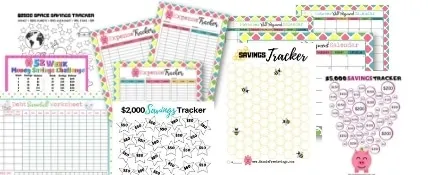*This post may have affiliate links, which means I may receive commissions if you choose to purchase through links I provide (at no extra cost to you). As an Amazon Associate I earn from qualifying purchases. Please read my disclaimer for additional details. Thank you for supporting the work I put into this site!
Making a monthly meal plan may not sound that easy at first, but it definitely pays off in the long term. With jobs, chores, hobbies, family, friends, and all the other things that take part in your schedule, it’s really not that easy to coordinate everything on a daily basis. Who can consistently come up with new ideas for healthy meals every day?
That’s why planning in advance may help, especially on monthly basis. Just sit down, grab a pen, take some time, and start making a schedule for the next 30 days. Not sure how? Let’s check it out together!
First of All, Why Should You Plan Your Meals?
It’s a Time Saver
Writing your tasks down generally helps you to be more efficient and productive. When you plan your daily/weekly/monthly meals, you’re more likely to avoid dilemmas of what you should cook that day.
When everyday life gets busy, the last thing we usually think about is food. Who wants to come up with some new, creative, and healthy recipes at such times? Most of us simply reach for the easiest solution, which often turns out to be junk food.
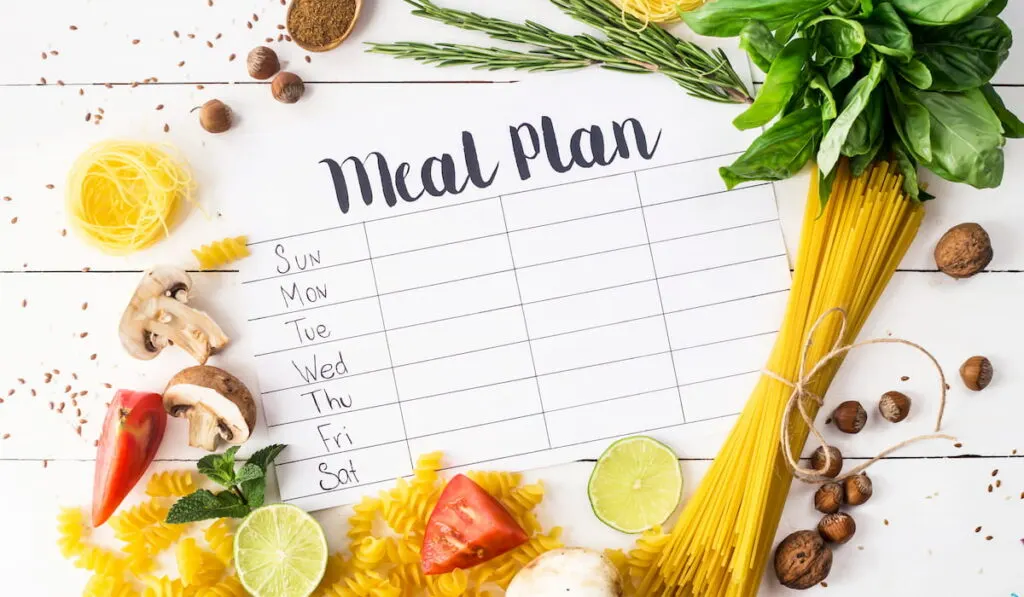
That way, having it all on paper really saves time and helps you stay on a healthy diet track.
It Also Saves You Money
How often does it happen you go to a supermarket and come back with a bunch of things you didn’t plan to buy at all?
Plenty of snacks, sweets, foods with short expiry dates, or unusual foods you’ve never tried, but “might do this time.” It’s all a trap we fall into whenever we take an aimless excursion to the supermarket. The real question is—how many of such “trips” can your wallet take?
In other words, making a monthly plan helps you determine what you will have to buy, as well as calculate how much of something you really need. That way, you’ll know how much money you generally spend on food, which makes it easier to take better control over your finances.
Planning Helps With Healthier Diet
As mentioned above, going to the supermarket without a list is not such a good idea. Of course, we’re not robots; if you really find some cool, tasty foods that are not on the list, it’s fine if you want to treat yourself.
Making a plan doesn’t imply we should strictly stick to it—it means we want to create a better direction and make a good-quality diet base.
However, try following the list you’ve made whenever possible. If you want to make some changes and improve your diet, it’s essential to fill your kitchen cabinets with healthy foods instead of sweets, processed snacks, foods with no nutritional value, etc.
Having a list helps with keeping the focus on foods you really want to implement into your menu.
You’ll Avoid Wasting Food
Of course, we can overdo it when it comes to healthy foods, too. For instance, you may buy too many vegetables or some other things with a short expiration date. Since you won’t have enough time to eat all that, the food, unfortunately, goes to waste.
Planning your meals in advance helps you determine the amounts you need for your daily/weekly/monthly diet plan. Still haven’t figured how much food you need? No worries, you’ll learn to adjust it through time and reduce food waste to a minimum.

More Creative Recipes
When you come home from work and try to squeeze family, friends, regular chores, and some rest time into your schedule, pretty soon it becomes obvious not much time is left for cooking.
So, most of the time you’ll probably go with the simplest solution, even though you may not feel like eating the same meal for the fourth time this week.
Look for new recipes when you’re not cooking. It’s easy to experiment and look for creative recipes when you have the entire afternoon free.
However, when your schedule becomes tight, you probably want to go for the quickest solution out there. So, when making a monthly plan, simply add a list of easy-to-prepare, yet healthy meals that’ll come in handy on working days.
How To Make A Meal Plan For a Month?
You approximately have 30 days in a month to fill. Print out an empty schedule and let the fun begin!
Write Down Regulars
Do you enjoy having pizza once a week? Would you like to turn Tuesday into a fish day? Either way, fill the days with ‘regulars’ first. You’ll be surprised how quickly you’ll fill your schedule this way.
Plan Three Main Meals
Of course, you can plan only one meal (that’s essential for your day), but it would be a lot easier for you to have a general plan of what you could eat during all periods of the day.
Write Down Things You Always Need To Have In Stock
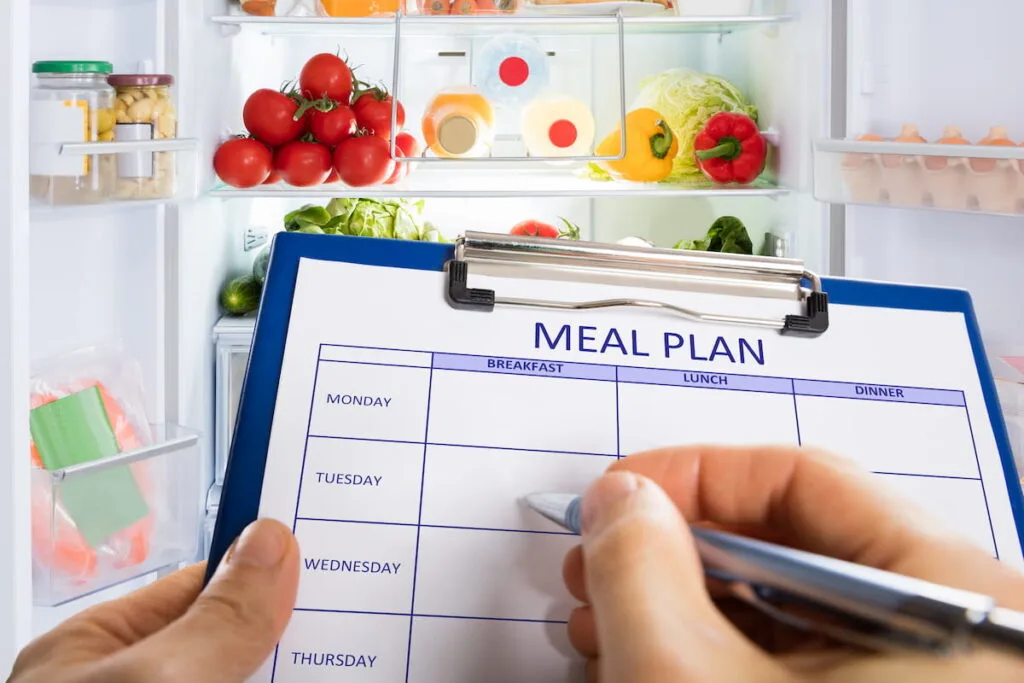
Okay, day number 17 has come, and you simply don’t feel like eating what’s on the menu. No problem, just make sure to always have certain foods with longer expiration dates in stock.
For instance, you can keep canned tuna, baked beans, potatoes, frozen berries, frozen fish, and much more in the pantry or freezer for options.
Cook For More Days
It’s definitely easier to write down your ideas than to do the actual work. Considering that, why should you even cook every day? Calculate the amounts of food you need per one day and double it to save some time.
Pasta, risottos, soups, and stews are just some of the simple meals you can keep in the fridge for 2-3 days.
You can even make bigger amounts of a certain meal, divide it into smaller portions, and keep it in the freezer. That especially comes in handy during days when you don’t feel like cooking, but would still prefer to have a healthy bite.
Also, pause the meal plan when you have some leftovers.
Check The Family Calendar
The day has only 24 hours, and cooking is an activity we often adjust to other, more important things in our day. Maybe you have a dentist appointment, need to take kids to the football, or have some arranged family gatherings.
Simple meals or preparing amounts that will be enough for 2-3 days can certainly help during those busy days.
Brainstorm
If there are ingredients you always have in stock, put them on paper while doing your plan, and see what you can combine there. It’s hard to be creative with recipes when you’re tired after a long day, so you’ll certainly appreciate some side ideas waiting for you in those moments.
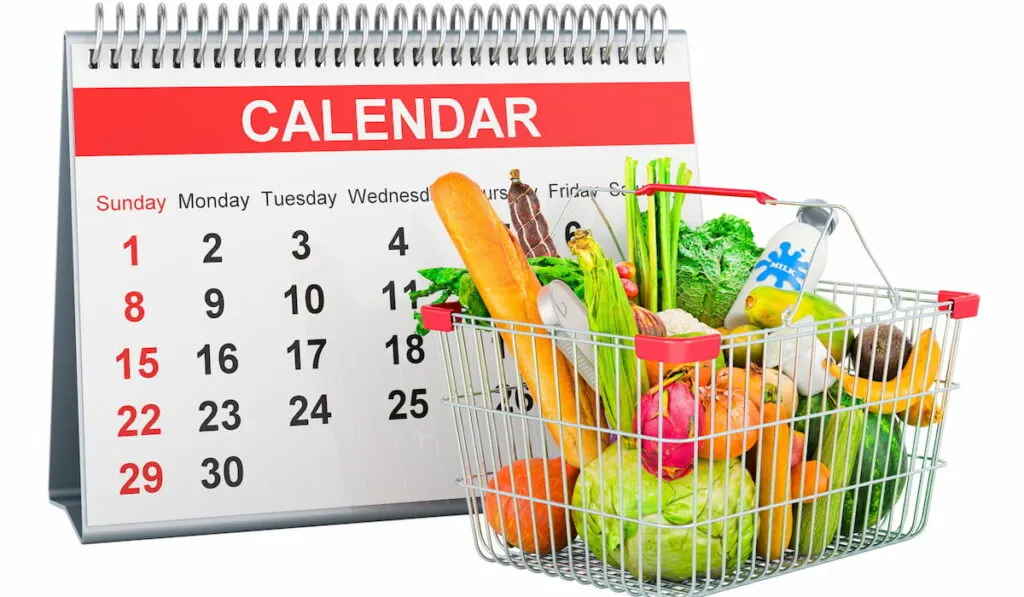
Some Terms We Should Explain Before We Start Planning
Macronutrients provide your body with energy. The three main macronutrients are fats, carbohydrates, and proteins.
Proteins are made of amino acids, and our body cells need them to mend their structure, perform their functions, and grow.
In other words, they are vital for building and maintaining our muscle mass. You can find protein in plenty of foods such as eggs, fish, meat, beans, dairy products, poultry, etc.
Carbohydrates are the main source of energy for our body. They fuel our brain, central nervous system, kidneys, and heart muscles.
Fats protect our organs, support cell growth, provide our body with energy, help the body absorb important nutrients, and keep our blood pressure and cholesterol under control.
Fiber is a very important element that boosts digestion. Research has shown dietary fiber slows down the absorption of carbs, which causes a slow, but a balanced rise in blood sugars. That way you avoid spikes in your blood sugars—something that refined sugar causes.
Antioxidants are substances in charge of preventing or slowing damage to our cells. That way, we slow down the aging process and keep our bodies in better condition.
Should you have whole-grain wheat or refined wheat? Whole grains are minimally processed, unlike refined wheat.
They are rich in vitamins, minerals, fiber, and antioxidants, plus they bring lots of health benefits like lowering risks of certain diseases such as type-2 diabetes, heart disease, and more. Try to buy “whole-wheat” labeled rice, pasta, and some other wheat goods.
Let’s Start Then!
Breakfast
A good breakfast is there to fuel your body as well as give you enough energy to start your day. Below is a list of foods you could add to your morning routine:

Eggs and dairy products such as cheese, (Greek) yogurt, milk, etc.
Try to choose whole grains over refined ones. That means oats, whole-wheat goods, corn, whole-grain bread, rye (mostly darker one, since the light and medium variations are typically refined), buckwheat, or brown rice.
Buckwheat is one quite easy-to-prepare pseudocereal; add one cup of buckwheat to two cups of water. Bring everything to a boil, reduce the heat level and let it simmer for the next 10-15 minutes or until it tenders.
Also, brown rice is a better choice than white rice. It’s actually a whole grain, which means it has the entire grain: bran, germ, and endosperm. White rice is not, since the bran and germ are removed, which makes brown rice a better choice.
Fruits are always a great choice that will freshen your morning. You can go with classics such as apples, bananas, cherries, kiwi, or pineapple.
Also, how about berries? Raspberries, blueberries, blackberries, strawberries are all quite tasty, rich in antioxidants, lower in sugar compared to most other fruits, and higher in fiber.
Citrus fruits include limes, oranges, grapefruit, mandarins, lemons, and plenty of other hybrids and varieties. They’re rich in vitamins, great for boosting our immune system, an excellent source of fiber, low in calories, and bring many benefits for your overall health.
Avocado is a fatty and extremely nutritious fruit. It’s rather delicious as well as easy to fit into most of your breakfast combos!
When it comes to vegetables, perhaps you can go for spinach, kale, tomatoes, green salad, broccoli, cauliflower, carrots, zucchinis, etc.
Seeds are also mini packets of important nutrients you can easily add to your breakfast. There are flaxseeds, chia, sesame, pumpkin, sunflower seeds, and many more.
How about nuts? They are a nutrient-dense food that keeps you full and comes as a great, easy-to-combine addition to your breakfast. You can go for almonds, walnuts, pistachios, Brazil nuts, pecans, cashews, hazelnuts, macadamia nuts, peanuts, etc.
Smoothies are a great way for people that prefer a light, yet nutritious liquid meal. The base can be water, milk, or yogurt. Later on, you can add seeds, fresh, dried, or frozen fruits, nuts, or some other ingredients you might like.
Some Breakfast Ideas:
Omelet or scrambled eggs with vegetables + Avocado + Cheese + Whole-grain bread
Orange + Raw spinach + Seeds + Water (Smoothie)
Frozen berries + Banana + Honey + Seeds + Oats (Smoothie)
Sauteed kale or spinach + Open-face egg + Whole-grain bread
Oatmeal + Yogurt + Berries or some other of your favorite fruits
Lunch
Lunch is an important meal that is supposed to be highly nutritious in order to energize your body for all upcoming tasks and obligations. Let’s go through the list of foods you could include here:
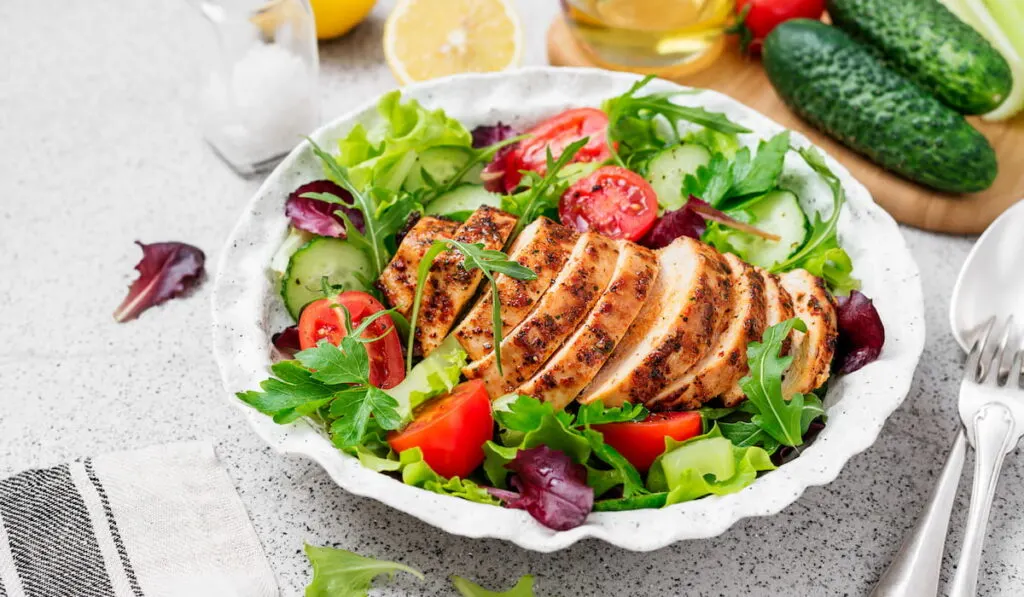
Fish is packed with omega-3 fatty acids, calcium, phosphorus, minerals, and valuable vitamins. It is recommended to eat it at least twice a week.
Here are some of the fish you might like: salmon, tuna, tilapia, cod. Budget-friendly solutions are dorade, porgy, skate wing, catfish, red mullet, sardines, and mackerel.
Many claim red meat can be harmful to our health, but the truth is a little bit more complex than that.
First of all, today’s meat is not the same as it was before. Animals used to freely roam around and eat grass, insects, or other things nature provided them with.
Also, a major part of meat today goes through many processing methods. It’s very important to distinguish between grass-fed, organic meat and factory-farmed, processed meat. The former is a better option since it is higher in nutrients.
Generally speaking, red meat, when properly cooked, is one of the most nutritious foods humans have eaten throughout our entire evolution. It is rich in vitamins, iron, zinc, selenium, protein, and fat. Here you can go with beef, pork, veal, goat, etc.
Poultry is another excellent source of protein as well as a package of numerous other valuable nutrients our body needs such as iron, zinc, iodine, vitamins, and fatty acids. It’s recommended to eat poultry every week for a balanced diet. Same as with red meat, stick to the unprocessed poultry when possible.
Beans and legumes are a good source of protein and important nutrients. They also can be a replacement for meat if you’re vegetarian or would simply prefer to have more variety in your diet. You can go with chickpeas, lentils, peas, kidney beans, black beans, etc.
Vegetables are a great side dish for any meal in the day, so we’ll just expand the previous list of ideas with asparagus, eggplant, lettuce, cabbage, potatoes, beetroot, butternut squash, etc.
Mushrooms are classified as vegetables, but technically speaking, they’re a part of the special kingdom called fungi. We’re talking about low-calorie foods packed with plenty of vitamins and minerals. Mushrooms are really easy to implement in so many different meals, no matter what time of day it is.
Side salad combinations may consist of cucumber, green salad, peppers, radishes, tomatoes, and many other vegetables.
Some Lunch Ideas:
Tuna steak + Potato salad + Homemade tomato sauce
Bean stew + Sausage + Green salad
Pasta + Your favorite veggies
Meat + Baked broccoli and cauliflower covered in cheese + Side salad
Dinner
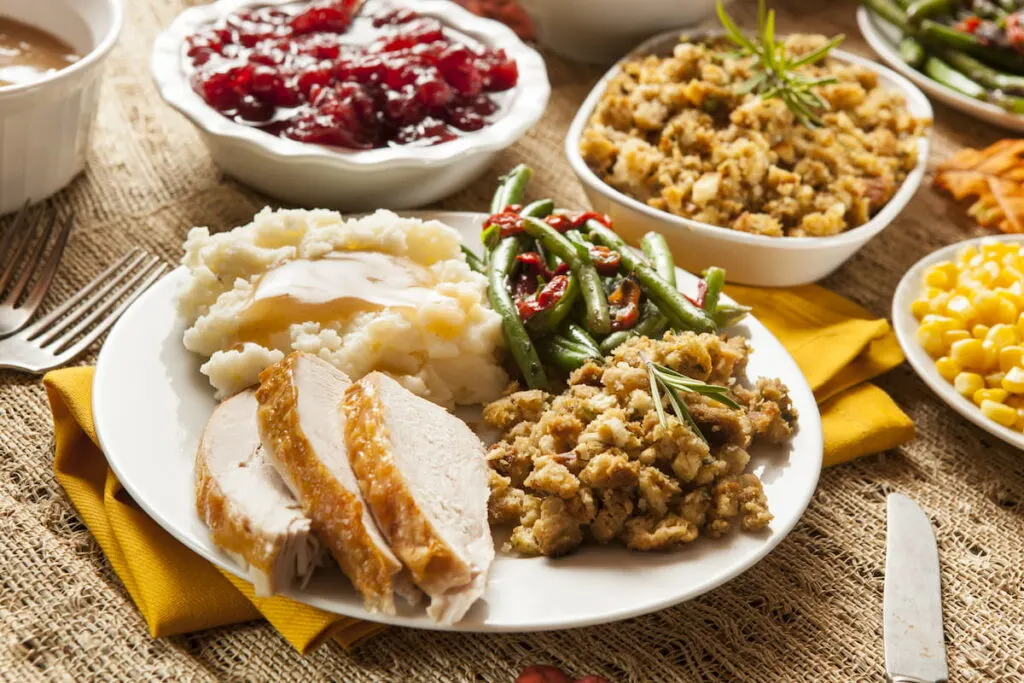
Throughout the day, we need more energy to pursue work, chores, and all other daily tasks we might have.
Still, things are a little bit different when it comes to dinner. Since you’re preparing for the rest, perhaps you’d like to go with a lighter meal your body will easily digest overnight.
Healthy sandwiches are a great solution when you don’t feel like cooking. Combine a couple of ingredients you can find on the ‘breakfast’ and ‘lunch’ list, or simply find some of your own tasty combos.
Soups are a great way to finish your day or even fulfill your lunch and dinner menu. When thick and creamy, soup can even be a meal in itself. Some of the popular creamy soups are made of broccoli, tomato, butternut squash, or some other delicious veggie.
Salads can also be an excellent side addition, but why not occasionally turn them into the main dish? Simply add chicken or fish, and enrich them with beans, corn, cheese, eggs, greens, and different types of your favorite vegetables.
Some Dinner Ideas:
Butternut squash soup + Whole-grain bread + Cheese + Green salad
Tuna + Avocado + Tomatoes + Cheese + Various veggies (Mixed salad)
Whole-grain bread + Avocado + Eggs + Greek yogurt
What About Snacks?
Snacks can be tricky. Picture this: it’s a lazy afternoon, you are hungry, and dinner is not going to be ready for two to three more hours.
What are you going to eat? Most of us will basically grab whatever we have within reach. Now, open the cabinets in your kitchen. What do you have there?

If there are a bunch of sweets and processed snacks, it will be a huge temptation and obstacle on your way towards a healthier diet. It’s easier if you just replace them with nuts, fruits, and other healthier variations.
It’s okay if you can’t completely give up on processed snacks; you can set ‘cheat days’ within your schedule, which is a great way to automatically reduce the amount of snacks and sweets you buy.
P.S. Popcorn can be a nice, tasty, and a bit healthier replacement for those classic snacks.
Rules Are Not Strict!
Of course, the examples you saw above are not a strict plan you should entirely stick to. It’s more like a set of ideas you can combine and adjust to your own preferences.
Maybe you don’t like eating eggs in the morning and prefer to have them for dinner? You’d like to start your day with vegetable soup? Excellent! Choose foods you like, play with ingredients, and create some of your own tasty and nutritious combos!
Don’t Forget ‘Cheat Days’!
If you want to make your diet healthier and set too many restrictions, you’re more likely to give up on everything.
Planning your meals on a monthly basis can certainly be beneficial and can help with choosing healthier ingredients, but it’s okay to occasionally treat yourself with junk food, sweets, or processed snacks.
The monthly meal plan is supposed to help you create a good base—and when you have that, it’s easier to allow yourself guilt-free cheat days.
How To Stay Within A Budget?
As we’ve already mentioned, planning your menu in advance helps with taking control over things you buy. It also saves the money we all tend to spend on unhealthy snacks or foods that end up wasted.
Other than that, when you plan grocery shopping, you can keep an eye on discounts. Eating healthy really isn’t expensive—all you need is a good plan you’ll stick to (at least most of the time).

What About Kids?
The food industry spends billions of dollars on marketing campaigns that promote sweetened cereals, candies, juice drinks, and other processed junk foods to kids and teenagers.
Refined sugars and other unhealthy elements in junk foods are difficult to completely avoid. However, you don’t even have to. It’s okay to have an occasional treat and enjoy your cheat day.
A healthy diet base is something that counts, which is why it’s very important to get your kids used to a healthy diet from an early age.
Find healthy combos your kids may like, introduce them to various types of vegetables, help them discover some tasty, yet healthy snacks.
Kids need a varied diet the same way adults do; the main difference is caloric requirements. For instance, the average adult needs around 2,000 calories on a daily basis, while children from ages 9 to 13 need 1,400 – 2,200 calories. The amount varies on their activity level and growth.
The earlier you start teaching them to eat healthily, the more they’ll be willing to accept high-quality foods over processed ones.
What If It’s Too Hard For You To Stick To Your Monthly Plan?
Don’t worry, it’s not your fault. Making a plan is one thing, but sticking to it is something entirely different. If you’re struggling with discipline, try taking a step by step.
Make a plan on a weekly basis and then expand it gradually. What matters is for you is to develop a habit where you write things down and plan ahead.
The fast-paced rhythm of the modern world simply doesn’t leave enough time to improvise or think about what we should cook or generally do with our free time.
In other words, the more we automate certain things in our schedule, the better our quality of a life and the more time for ourselves we get.
Also, having a schedule doesn’t mean you’re a robot that can’t do anything that’s out of the plan. Of course, unplanned things can happen. Your friends might spontaneously drop by, you can get ill or be extremely tired from a day at work.
Life happens, and there’s nothing we can plan that strictly. However, having a well-organized base for those regular days when things go according to plan really affects overall satisfaction with our lives.
Some Final Words
Are you good at organizing things? Making a monthly meal schedule will certainly be fun if you are. On the other hand, don’t worry if you’re not disciplined enough.
As we’ve already said, take it step-by-step, and the fun part will come when you catch up with all things your plan requires. What matters is to stay consistent and keep up with your plan, even if you fail from time to time.
So, tell us, will you start making your plan?
Sources:
- https://www.webmd.com/diabetes/qa/what-is-protein
- https://www.healthline.com/nutrition/whole-grain-foods
- https://www.mayoclinic.org/healthy-lifestyle/nutrition-and-healthy-eating/in-depth/fiber/art-20043983
- https://www.livescience.com/53044-protein.html
- https://www.healthline.com/nutrition/whole-grain-foods#TOC_TITLE_HDR_13
- https://www.healthline.com/nutrition/9-healthy-nuts#TOC_TITLE_HDR_7
- https://tasty.co/article/emofly/more-vegetables-for-breakfast
- https://blog.jumpinforhealthykids.org/healthy-breakfast-ideas-15-ways-to-eat-more-fruits-and-vegetables
- https://www.healthline.com/health/food-nutrition/healthy-meal-plans-for-kids
- https://www.healthline.com/nutrition/citrus-fruit-benefits#TOC_TITLE_HDR_10
- https://www.doh.wa.gov/communityandenvironment/food/fish/healthbenefits
- https://www.thekitchn.com/easy-no-fail-fish-dinners-259658
- https://www.epicurious.com/expert-advice/7-budget-friendly-sustainable-fishes-to-cook-now-article
- https://www.healthline.com/nutrition/is-red-meat-bad-for-you-or-good#TOC_TITLE_HDR_2
- https://www.betterhealth.vic.gov.au/health/healthyliving/Meat-and-poultry
- https://www.healthline.com/nutrition/healthiest-beans-legumes#TOC_TITLE_HDR_7
- https://www.producemarketguide.com/category/salad-vegetables
- https://fruitsandveggies.org/stories/mushroom-shedding-light-on-their-nutritional-value
- https://www.webmd.com/food-recipes/features/the-truth-about-red-meat
- https://www.reidhealth.org/blog/carbohydrates-101-the-benefits-of-carbohydrates
- https://www.health.harvard.edu/staying-healthy/know-the-facts-about-fats
- https://www.healthline.com/nutrition/6-healthiest-seeds
- https://dontwastethecrumbs.com/monthly-meal-plan/
- https://goodcheapeats.com/meal-planning-101-plan-for-a-whole-month/
- https://www.medicalnewstoday.com/articles/301506
- https://www.reidhealth.org/blog/carbohydrates-101-the-benefits-of-carbohydrates

